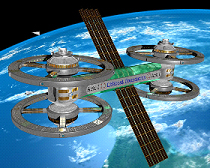The project of a space habitat as a backup plan for
human civilization is still at a very early stage. This, however does not mean
that there is not much done in this field at the moment. On the contrary as the
Lifeboat Foundation is currently working on rendering space flights beyond the
atmosphere cheaper and come up with non-rocket methods for reaching the orbit.
The most prominent name within the Lifeboat Space habitat mission is ‘Ark1’.
 ‘Ark 1’ is a self-sustaining space habitat, which
should be made capable of ensuring the survival of humanity in the event Earth
becomes uninhabitable. The artificial ecosystem should also include plants and
animals and will resort to resources from the moon and asteroids since acess to
the Earth, which will not be existent by this moment in time will no longer be
an option. The living quarters of Ark I will be a set of two spinning wheels
accumulating gravity. As an energy source, nuclear fission reactors and solar
panels will power the habitat. Ark I will be a test in terms of a
self-efficient environment as well as new ways of managing and obtaining
resources and finally for astronautic hygiene and space medicine.
‘Ark 1’ is a self-sustaining space habitat, which
should be made capable of ensuring the survival of humanity in the event Earth
becomes uninhabitable. The artificial ecosystem should also include plants and
animals and will resort to resources from the moon and asteroids since acess to
the Earth, which will not be existent by this moment in time will no longer be
an option. The living quarters of Ark I will be a set of two spinning wheels
accumulating gravity. As an energy source, nuclear fission reactors and solar
panels will power the habitat. Ark I will be a test in terms of a
self-efficient environment as well as new ways of managing and obtaining
resources and finally for astronautic hygiene and space medicine.